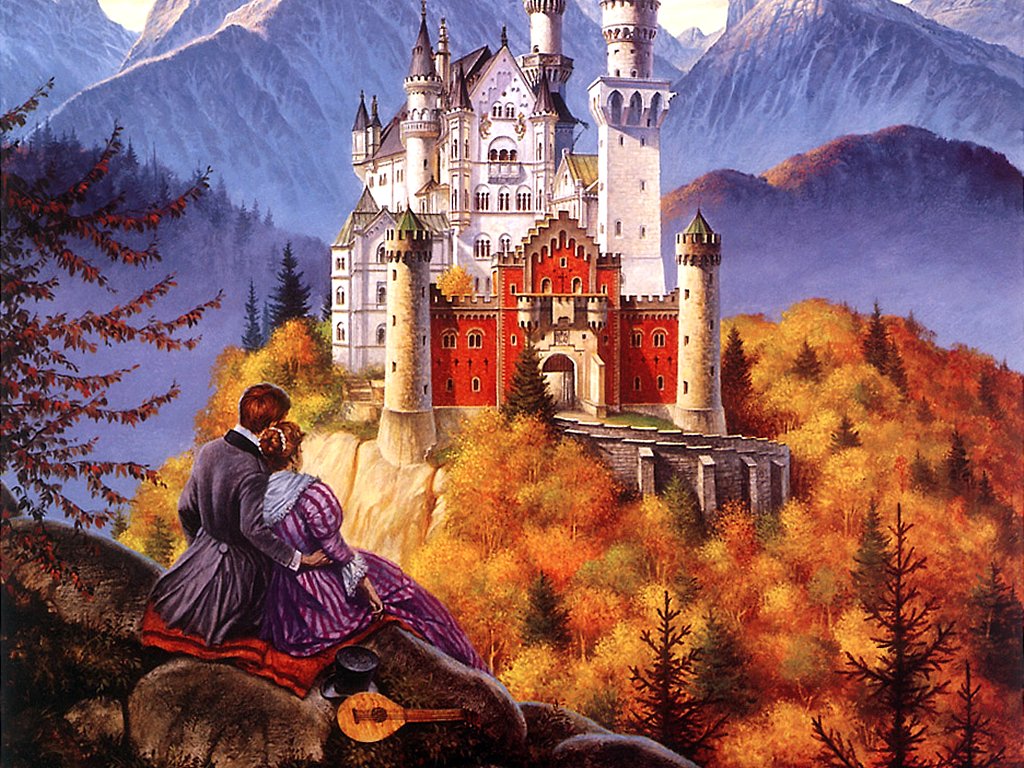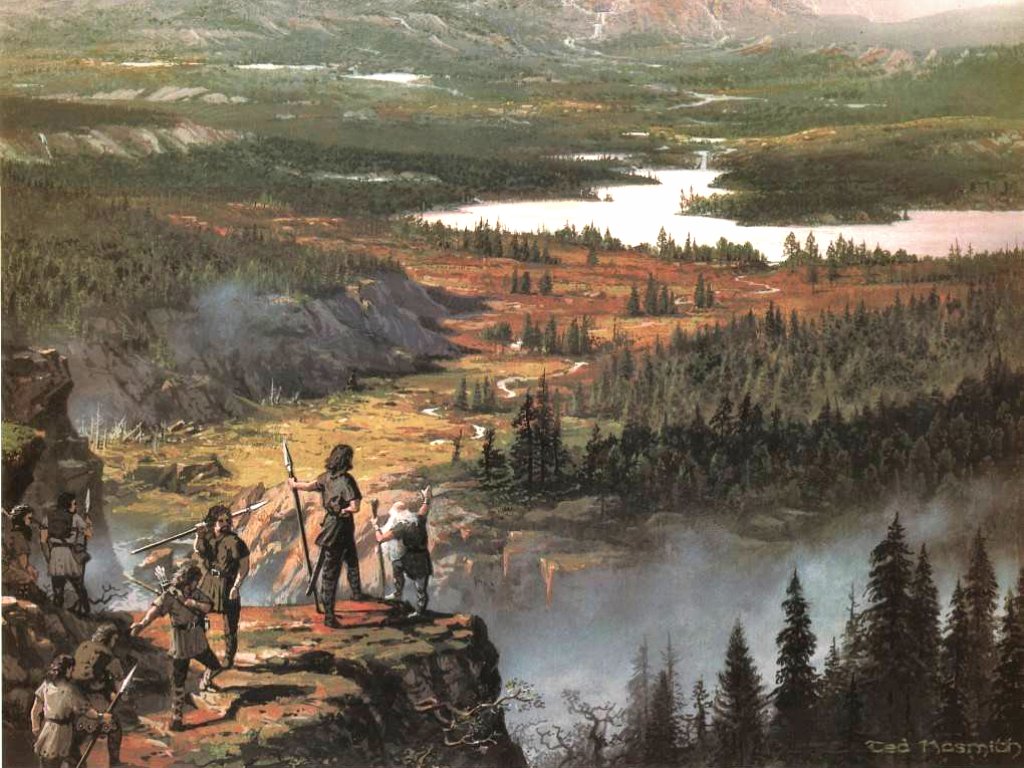

|
|
|
|
|
|
|
|
|
|
|
|
The power of sight is something that characters
often take for
granted - until they lose it. In the wilderness,
the ability to see a
great distance and know what you’re seeing
can make the difference
between being able to move FAST or slowly;
between surprising
and being surprised; and, sometimes, between
life and
death.
A character or creature can have as many
as three types of visual
senses -- normal vision,
infravision,
and ultravision. Each
one has advantages in some situations
and disadvantages at
other times.

Normal vision is what humans
and most other creatures and
character races use most of the time.
It is the ability to see images,
colors, and other visual phenomena within
the range of the
so-called “visible spectrum,” between
the infrared and ultraviolet
ranges of the full spectrum of light waves.
In clear air during
daylight, the effective range of normal
vision is 500 yards. This
means that a character with an unobsrrucred
view can see a size
M creature or object at this distance
well enough to recognize its
basic form. A creature or object of size
S is visible from 250 yards
away, and one of size L is visible from
a distance of at least 1000
yards - or perhaps a much greater distance
for exceptionally
large creatures or objects (such as a
dragon or a tall building).
“Unobstructed” is an important word here,
because practically
anything in the line of sight can be an
obstruction. When the
viewer and the target are both on the
ground and at the same elevation,
ideal viewing conditions are rare. If
a six-foot-tall orc is
standing in the middle of a flat and totally
featureless plain, its
form will be visible to a character 500
yards away. If the field is
covered with a three-foot height of grass
and foliage, the orc’s image
is smaller because only half of its body
is visible, and thus it
can only be viewed from 250 yards distant
(as if it was a size S
creature).
An unobstructed view often occurs when
the viewer and the
target are at drastically different elevations.
A character standing
on the peak of a lone mountain rising
high above the plain around
it can see for miles in any direction.
However, his effective range
of normal vision is unchanged; he must
still be within 500 yards of
a size M object or creature in order to
be able to distinguish its basic
form and possibly identify it.
Of course, the converse is true as well:
The character standing
on the peak is himself visible and recognizable
to any other viewers
within 500 yards. Obviously, long-range
visibility can be a
blessing and a curse at the same time,
depending on one’s point
of view.
Table 41: OUTDOOR RANGE OF NORMAL VISION (in yards) (x2 for L objects, 1/2 for S objects)
| - | Daylight | Twilight | Moonlight | Darkness |
| Clear | 500 | 300 | 50 | 25 |
| Overcast | 400 | 250 | 50 | 25 |
| Moderate fog | 150 | 100 | 25 | 15 |
| Heavy fog, rain, or snow | 50 | 30 | 15 | 10 |
| Heavy snow with wind | 35 | 25 | 10 | 5 |
| Blowing sand/dust | 20 | 20 | 10 | 5 |
Table 41: OUTDOOR RANGE OF NORMAL VISION (Fog only) (in yards) <make link to full table>
| - | Daylight | Twilight | Moonlight | Darkness |
| Moderate fog | 150 | 100 | 25 | 15 |
| Heavy fog | 50 | 30 | 15 | 10 |
Entries on this table are expressed in
yards. The given range is
the distance at which a viewer can discern
a size M object that
stands out from the terrain and other
surroundings adjacent to it;
double this figure for a size L object
and halve it for a size S object.
The ability to see something at the given
range assumes that
the viewer is concentrating on long-range
vision and that the target,
if one exists, is not concealed or attempting
to keep itself
from being seen. If the orc
from the above example were to lie
down in the middle of the flat, featureless
plain, a character’s
chance of spotting it from a long distance
would be greatly reduced.
And if it lies down in three-foot-high
grass, of course, it is
effectively invisible until the viewer
gets very close to its location.
In daylight or twilight, a character can
employ long-range normal
vision and short-range normal vision at
the same time; that is,
he can keep an eye out for obvious objects
immediately in front of
him and for objects in the distance simultaneously
(in effect), simply
by shifting his gaze every few seconds.
In conditions of sufficient
illumination, it is possible to move at
full normal speed and
remain cognizant of visible features at
both short range and long
range as long as the character keeps shifting
his gaze. Many objects
will become obvious at short range just
because they are obvious
For instance, it is practically impossible
for a character to
casually stroll over the edge of a cliff
in daylight or twilight even if
his attention is fixed on an object on
a distant mountain peak; his
field of vision will take in the edge
of the cliff before he gets to it -
assuming that he isn’t staring up into
the air and walking toward
the edge at the same time.
In moonlight or darkness, when illumination
is scant or practically
nonexistent, it is much more difficult
for a character to keep
moving and remain cognizant of short-range
and long-range objects
at the same time by shifting his gaze:
In the space of a few
seconds, a character could come upon the
edge of a crevass or a
pit that he didn’t see the last time he
looked at the area directly in
front of him. A lone character on the
move in moonlight or darkness
is usually better off paying attention
to what he’s walking on
instead of what he’s walking toward, unless
he is sure that the terrain
immediately in front of him is not treacherous.
If two or more
characters are traveling together, they
can best protect themselves
by dividing “lookout duty”; one peers
far ahead, while another
pays close attention to the ground a few
paces in front of
them. Of course, the safest way to scan
the distance in conditions
of poor illumination is to first come
to a stop and then peer ahead
into the darkness - but even that will
not make a character safe
from a hazard that is nearby and moving
toward him, silent and
unseen.. . .
Artificial
Illumination
-
-
Some important statistical information
about artificial light
sources is given on page 102 of the Players
Handbook. The details
in this section supplement that information
and provide more
facts relevant to the outdoor environment.
The use of an artificial light source
in moonlight or darkness will
enable characters within the area of illumination
to see with normal
vision as if the natural light was twilight
(or perhaps daylight,
as in the caseof a continual light spell).
However, the specified radius
of illumination of the light source takes
precedence over the
figures on the Range of Normal Vision
Table (above). For instance,
a character holding a torch on a clear
night can only see
his surroundings out to a radius of 40
feet (the torch’s radius of il-
lumination), even though in actual twilight
conditions under a
clear sky he would be able to see 300
yards without the aid of a
light source.
The radius of illumination and the burning
time
of a
torch can both be affected by wind
velocity. If the wind is blowing
at less than 10 mph, the
figures given in the PH apply.
* If the wind
is between 11 and 25 mph, the flame of the
torch will struggle
and flicker, providing reliable illumination only
out to 30 feet instead
of 40, and the torch will burn out in 4 turns
instead of 6.
* If the wind
is between 26 and 40 mph, radius of illumination
is not further reduced
but the flame will only last for 2
turns at most, and
there is a 25% chance (checked every five
rounds) that the torch
will be extinguished by the wind and must
be reignited.
* In a wind
of more than 40 mph, it is impossible to
keep a torch burning
for more than 1 round.
-
It takes 1 round to light a torch, plus
1 round for every 10 mph of wind velocity;
this time is cut in half for a character
with proficiency in fire building.
In moonlight || darkness, a lighted torch
can be seen from as far
away as 200 yards.
<*** note: in D&D Basic, a torch does 1-4 points of damage when used as a melee weapon>

Q: Can a torch be
used as a weapon?
How far can a torch be thrown?
There are some instances
when it is
desirable to use a torch
as a secondary
weapon; is this allowed?
A: Torches can be
used as primary weapons;
treat them as clubs
for all purposes?
even when throwing and inflicting
damage, assuming that the
torch is lit and
the target is not immune
to fire. A torch
may be used as a secondary
weapon if the
DM thinks the situation
warrants it. Apply
the "Attacks
With Two Weapons" rule on
page 70 of the DMG.
If players attempt to
abuse the privilege, the
DM might have a
character set fire to himself
or his equipment.
Have the torch either save
vs. normal
blow as thin wood, or break.
The fire
has a 10% chance of going
out per blow.
(150.38)
Lantern: A lantern || a bullseye lanthorn is generally much more reliable as a light source in the wilderness.
The flame is protected, so it will not
flicker or be extinguished by the wind,
and the radius of illumination generally
remains constant.
* In moonlight || darkness,
the light from a regular lantern can be seen from 100 yards away.
* The __beam__ of light
from a bullseye lanthorn can be seen from 200 yards away if the viewer
is looking directly back toward the source of the light,
or from 100 yards away if the viewer’s gaze is directed across the path
of the beam.
-
Magick
weapons: This kind of light source illuminates a smaller
area than a torch
or a lantern does, but it has the advantages of
not needing fuel
and not being affected by the wind. In moonlight
or darkness, the
glow of a magic weapon can be seen from a distance
of ten times its
radius of illumination:
100 feet for a magic dagger,
150 feet for a magic short sword, or
200 feet for a magic long sword.
The use of any artificial light source
(including magical light) in
moonlight or darkness limits long-range
visibility to varying degrees
for all characters within the illuminated
area. A character
holding a lantern, for instance, will
not be able to make out any
details in the darkness immediately beyond
the 30-foot radius
that the lantern illuminates. However,
someone standing at the
fringe of the illuminated area can still
see normally into the darkness
ahead of him. If a group of characters
is attempting to travel
at night with the aid of artificial light,
the DM should
take note of which characters are carrying
light sources and
where other characters are located with
respect to the lightholder
to determine what the group can and cannot
see as they
move along.